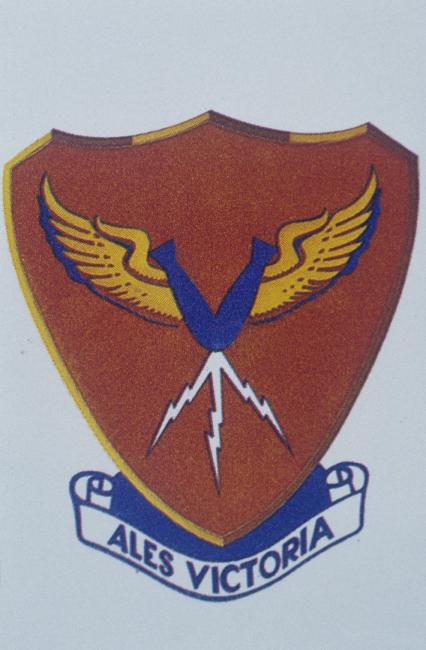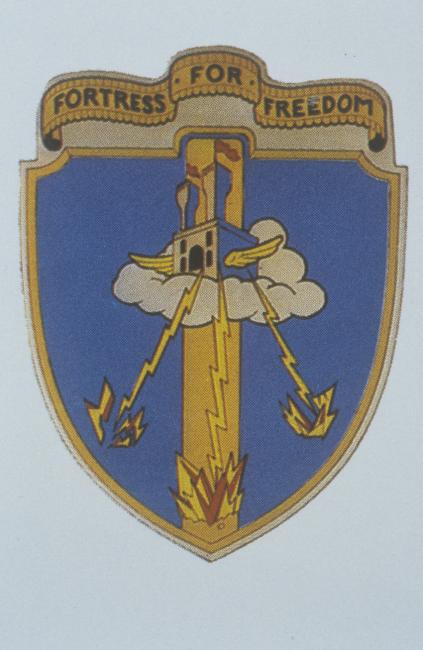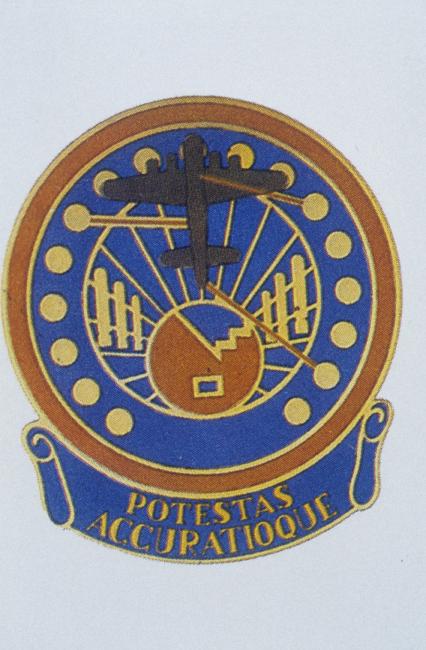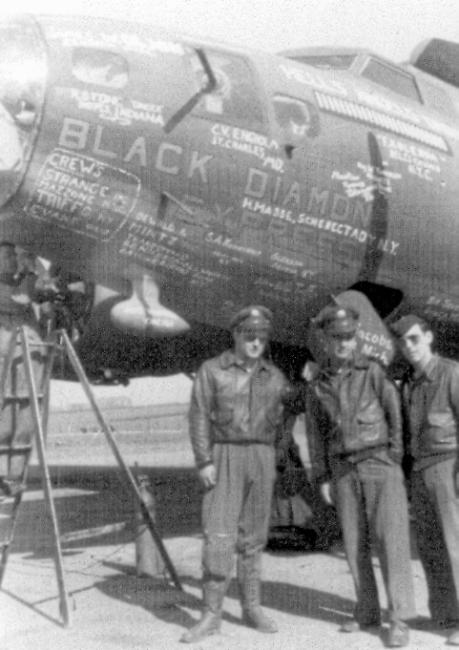VIII Bomber Command 115
14 October 1943![Three B-17 Flying Fortresses of the 94th Bomb Group are attacked by a Nazi Fighter aircraft during a mission. Printed caption on reverse of print: 'A-62641 USAF: Nazi fighter plane attacking Boeing B-17 "Flying Fortresses" during a bomb run over enemy installations somewhere in Europe, 10 September 1944. 100th[sic] Bomb Group, 3rd Bomb Division. U.S. Air Force Photo.'](https://assets.americanairmuseum.com/s3fs-public/freeman/media-408505.jpg)
IWM, Roger Freeman Collection
Object Number - FRE 3872 - Three B-17 Flying Fortresses of the 94th Bomb Group are attacked by a Nazi Fighter aircraft during a mission. Printed caption on reverse of print:...
Description
This was the 2nd mission flown against the ball bearing industry at Schweinfurt, Germany and was as equally disastrous as that flown on 17-Aug-43. It came to be known as "Black Thursday". While fighter escort was dispatched, bad weather and lack of range of the P-47 aircraft meant that the bomber stream had to "go it alone" for much of the mission. Unlike the 17-Aug-43 mission, all aircraft were directed to return to their bases in England following the attack rather than any formations proceeding to bases in North Africa.
Three elements were designed to fly the mission. The first element is a combined force of 149 B-17s of 1st Bomb Division that included 91BG(11); 92BG (19); 303BG (19); 305BG (16); 306BG (18); 351BG (16); 379BG (17); 381BG (17); and 384BG (16). This force would be the first over the target. 101 managed to bomb on the target. 45 aircraft Failed to Return (FTR) 148KIA 274POW of which 3 Died in Captivity (DIC) 16EVD 10INT (in Switzerland); 6 aircraft returned to England Damaged Beyond Repair (DBR) 60RTD. 29 airmen in returning aircraft were Wounded in Action (WIA). 305BG lost 13 aircraft and 306BG lost 10. The bomber gunners claimed 91-16-53 of attacking German fighters.
The second element was a combined force of 142 B-17s from 3rd Bomb Division that included: 94BG (21); 95BG (18); 96BG (41); 100BG (8); 385BG (21); 388BG (18); and 390BG (15). 128 aircraft were successful on the target. 15 aircraft Failed to Return (FTR) 7KIA 111POW 22EVD 10RTD (rescued by ASR); 2 aircraft returned to England too damaged to repair (DBR) 21RTD. In addition 3 airmen baled out of an aircraft that returned and were captured as POWs 3POW 7RTD. 1 aircraft crashed on takeoff and was (DBR) 11RTD. 75 aircraft were damaged. 11 airmen in returning aircraft were Wounded in Action (WIA). The bomber gunners of this element claimed 95-11-36 of attacking German aircraft. 390BG was awarded a Distinguished Unit Citation (DUC 2of2) for their actions on this mission.
The third element was a combined force of 60 B-24s from 2nd Bomb Division were dispatched to also bomb at Schweinfurt but poor weather frustrated formation and only 29 aircraft from 93BG (15) and 392BG (14) were able to form up. These abandoned the Schweinfurt attempt and instead flew a diversion towards Emden. There were no losses or claims in this element.
In the course of 4 days, 10-Oct-43 thru 14-Oct-43, that "Mighty Eighth" lost 90 crews and aircraft. The loss rates stunned higher command and finally convinced them that the "Flying Fortress" while very formidable was not fully capable of conducting raids deep into German without adequate fighter support. Also while German industry was the focus of the daylight bombing campaign, the most immediate threat was from a very formidable Luftwaffe fighter force, which could only be destroyed if enticed to attack bomber formations, but only if a long-range fighter can engage the attacking fighters.
The 305th Bomb Group on Black Thursday
While looking for information on Donald Paul Breeden and his crew, I read some books about this ‘Back Thursday’ and the way in which the 305th Bomb Group was hurt on this raid - Mission 115 - into the well defended German heartland.
I did read a book about the Mighty Eight and the books with personal stories like by John Comer and Steve Snyder. While looking into the story of Grandpa Dassen his bomber boots I’ve read on the internet about the evaders like Stan Alukonis and Steve Krawczynski. Also from Mr. Roberts’ and Mr. Linrud’s stories I got a good idea of their adventures and feelings.
Mr. Caidin is mild in his book while Mr. Kuhl in his is very outspoken on the leadership of the 305th Bomb Group on that Black Thursday: Normand had to little experience on flying B-17‘s, on leading and was not recommended for more leading by his former CO. But on the 14th he was the leader.
Who ever is right, it does not change the big losses of men and machines from this group in which the 364 Bomb Squadron of Donald Paul Breeden and his fellow crew members was the one who was hit hardest.
Other things went wrong as well. The Germans were alerted by the message from Gen. Anderson that was sent ‘in the clear‘ instead as ‘secret’ on 13th of October just before midnight. So some 1.100 German planes were ready and on alert.
Due to gathering problems because of the bad weather over England the US fighter escort had to return earlier than planned. It is also said that they started to early so lost gas on waiting for the combat boxes of B-17’s.
The escorting P-47’s left at 13.33 hours. Map reference 5102N-0555E is between Genk and Opglabbeek in Belgium. Crash time of the A/C 42-3436 was around 13.45 hours; 12 minutes later.
Flying in the low group and fast still trying to get near their leader way after their ‘little friends’ had to turn home. Flying into a corridor of German airfields with about 1.100 fighters ready to attack and several cities surrounded with FLAK the 305th Bomb Group lost many planes - the second one crashed near Eygelshoven.
Of the 305th Bomb Group only 3 B-17’s reached Schweinfurt. And only 2 made it back home to Chelveston. The B-17 of Dienhart/42-30831 of the 364th squadron crash landed in Switzerland.
The 364th squadron was totally destroyed that day - within 13 minutes and before it even could cross the Rhine.
From the book by Mr. Kuhl I got most of this information on the losses
of the 305th Bomb Group:
13.40 hours - Murdock 364th/#42 -29952 in Limmel (NL)
13.45 hours - McDarby 364th/#42-3436 in Eygelshoven (NL) and Finkenrath (G)
13.45 hours - Eakle 364th/#42-30807 in Eisden (B)
13.45 hours - Willis 366th/#42-3549 in Horn (NL)
13.49 hours - Dienhart 364th/#42-30831 turns south
13.50 hours - Holt 364th/#42-29988 in Immendorf (G)
13.50 hours - Fisher 366th/#42-3195 in Waldenrath (G)
13.52 hours - Lang 366th/#4237750 in Puffendorf (G)
13.53 hours - Kenyon 364th/#42-30242 crashed 4 miles W of Duren (G)
14.02 hours - Skerry 366th/#42-30814 in Adendorf near Bonn (G)
14.29 hours - Maxwell 365thth/#42-30804 exploded mid air - crashed near Glashofen (G), near Marktheidenfeldt, 15 miles NW of Würzburg (G)
14.32 hours - start bomb run over Schweinfurt by Kane/Normand - Bullock - Kincaid - Farrel
14.39 hours - Kincaid 365th/#42-3550 crashed near Werneck, 7 miles SW of Schweinfurt (G) before bombing
14.40 hours - bombs away by Kane/Normand - Bullock - Farrel
14.41 hours - Bullock 365th/#42-37740 NE of Schweinfurt (G)
15.40 hours - Dienhart 364th/#42-30831 crash-landed wheels up at Reinach Aesch (CH)
Returned safe in Chelveston after bombing
18.07 hours - Kane/Normand 365th/#42-3412
18.09 hours - Farrell 366th/#42-30678
From the mission report #115
291 B17’s started that day - 18 of 305 BG
37 aborted their flight - 3 of 305 BG
32 were lost en route - 11 of 305 BG
229 reached/bombarded Schweinfurt - 3 of 305 BG
28 were lost on return - 0 of 305 BG
201 came back home - 2 of 305 BG
138 B17’s were damaged
7 were damaged beyond repair - scrap ready
60 B17‘s were shot down
639 crew members were lost that day
Count on October 14 1943: 5 KIA, 40 WIA, 594 MIA
Mission Details
Aircraft Type: B-24 Liberator
Notes: 60 B-24s were scheduled to participate, but only 29 were able to from up because of the poor weather. This force abandoned the attack on Schweinfurt and instead flew a diversion towards Emden.

- Unit Hierarchy: Group
- Air Force: Eighth Air Force
- Type Category: Bombardment

- Unit Hierarchy: Group
- Air Force: Eighth Air Force
- Type Category: Bombardment
Mission Statistics
- Tonnage Dropped: 0.00
- Aircraft sent: 60
- Aircraft effective: 29
SCHWEINFURT (Primary)
Description: BALL BEARING FACTORIES
Aircraft Type: B-17 Flying Fortress
Notes: Bombing results are very good and damage is heavy. This raid causes the Germans to begin looking for ways to disperse the ball bearing industry to smaller sites. 96th Bomb Group goes "maximum effort" dispatching 41 aircraft. 96th Bomb Group also frunishes two crews to other Bomb Groups: one in 94th Bomb Group and one in 385th Bomb Group. The "Bloody Hundredth", still reeling from the 12 losses at Munster on the 10-Oct-43, only dispatches 8. 390th Bomb Group is awarded a Distinguished Unit Citation for this action (2 of 2).
![Three airmen of the 100th Bomb Group, Lieutenant Kenneth Menzie, Lieutenant Donald Strout and Lieutenant Norman Scott, plan the route they will take during the next mission in their B-17 Flying Fortress (serial number 42-30380). Image stamped on reverse: 'Reviewed and passed U.S. Army 23 Aug 1943 Press Censor E.T.O. U.S.A.' [stamp]'. Passed for publication 23 August 1943 INTLD 16 General Section Press Censorship Bureau '[stamp], 'Associated Press' [stamp] and '280035.' [Censor no.] Printed caption on reve](https://assets.americanairmuseum.com/s3fs-public/styles/max_650x650/public/freeman/media-378743.jpg?itok=oPPVVi6c)
- Unit Hierarchy: Group
- Air Force: Eighth Air Force
- Type Category: Bombardment

- Unit Hierarchy: Group
- Air Force: Eighth Air Force
- Type Category: Bombardment

- Unit Hierarchy: Group
- Air Force: Eighth Air Force
- Type Category: Bombardment

- Unit Hierarchy: Group
- Air Force: Eighth Air Force
- Type Category: Bombardment

- Unit Hierarchy: Group
- Air Force: Eighth Air Force
- Type Category: Bombardment
Mission Statistics
- People killed in action: 14
- People wounded in action: 11
- People evaded: 22
- Prisoners of war: 111
- People returned to duty: 49
- Enemy aircrafts destroyed by bomber: 95
- Enemy aircrafts probably destroyed by bomber: 11
- Enemy aircraft damaged by bomber: 36
- Aircraft sent: 142
- Aircraft effective: 128
- Aircraft missing in action: 16
- Aircraft damaged beyond repair: 5
- Aircraft damaged: 75
SCHWEINFURT (Primary)
Description: BALL BEARING FACTORIES
Aircraft Type: B-17 Flying Fortress
Notes: Daylight bombing suspension until 3-Nov-43. 305th Bomb Group's highest losses (61 Missing in Action (MIA)). Later referred to as "Black Thursday". 305th Bomb Group takes a beating losing 13 aircraft Missing in Action (MIA). Highest loss to a Bomb Group to date. Daylight bombing suspension until 3-NOV-43. The Luftwaffe is impressive even though the bomber gunners "claim" 186.

- Unit Hierarchy: Group
- Air Force: Eighth Air Force
- Type Category: Bombardment

- Unit Hierarchy: Group
- Air Force: Eighth Air Force
- Type Category: Bombardment

- Unit Hierarchy: Group
- Air Force: Eighth Air Force
- Type Category: Bombardment

- Unit Hierarchy: Group
- Air Force: Eighth Air Force
- Type Category: Bombardment

- Unit Hierarchy: Group
- Air Force: Eighth Air Force
- Type Category: Bombardment
Mission Statistics
- Tonnage Dropped: 459 X 1000GP 663 X 500GP 1,751 X 100 IB
- People killed in action: 153
- People evaded: 20
- Prisoners of war: 270
- People died in captivity: 1
- People interned: 9
- People returned to duty: 60
- Enemy aircrafts destroyed by bomber: 91
- Enemy aircrafts probably destroyed by bomber: 16
- Enemy aircraft damaged by bomber: 53
- Aircraft sent: 149
- Aircraft effective: 101
- Aircraft missing in action: 45
- Aircraft damaged beyond repair: 5
- Aircraft damaged: 63
Connections
See how this entry relates to other items in the archive by exploring the connections below.
People
- Military/Civilian/Mascot: Military
- Nationality: American
- Unit: 384th Bomb Group 544th Bomb Squadron
- Service Numbers: O-735151
- Highest Rank: First Lieutenant
- Role/Job: Navigator
- Military/Civilian/Mascot: Military
- Nationality: American
- Unit: 381st Bomb Group 535th Bomb Squadron
- Service Numbers: O-735735
- Highest Rank: First Lieutenant
- Role/Job: Pilot
- Military/Civilian/Mascot: Military
- Nationality: American
- Unit: 305th Bomb Group 364th Bomb Squadron
- Service Numbers: O-738530
- Highest Rank: Second Lieutenant
- Role/Job: Bombardier

- Military/Civilian/Mascot: Military
- Nationality: American
- Unit: 384th Bomb Group 547th Bomb Squadron
- Service Numbers: 14134547
- Highest Rank: Technical Sergeant
- Role/Job: Military Occupation Specialty 748-Army Airplane Mechanic / Gunner, Flight Engineer

- Military/Civilian/Mascot: Military
- Nationality: American
- Unit: 388th Bomb Group 560th Bomb Squadron
- Service Numbers: 16066310 / O-735023
- Highest Rank: Captain
- Role/Job: Pilot
Aircraft

- Aircraft Type: B-17 Flying Fortress
- Nicknames: Black Diamond Express
- Unit: 303rd Bomb Group 92nd Bomb Group 95th Bomb Group 326th Bomb Squadron 359th Bomb Squadron

- Aircraft Type: B-17 Flying Fortress
- Nicknames: What's Cookin' Doc
- Unit: 384th Bomb Group 547th Bomb Squadron 305th Bomb Group 422nd Bomb Squadron

- Aircraft Type: B-17 Flying Fortress
- Nicknames: Little Audrey
- Unit: 306th Bomb Group 384th Bomb Group Base Air Depot 1 368th Bomb Squadron 544th Bomb Squadron

- Aircraft Type: B-17 Flying Fortress
- Nicknames: The Duchess, Sure Stuff
- Unit: 303rd Bomb Group 359th Bomb Squadron

- Aircraft Type: B-17 Flying Fortress
- Nicknames: Bad Check
- Unit: 303rd Bomb Group 427th Bomb Squadron
Revisions
Changed "if attacking German fighters" to "of attacking German fighters" in description
Lee Cunningham 5-Jul-2015. Added bomber gunner claims to statistics of 1BD Groups per "The Mighty Eighth War Diary", Roger A. Freeman,
Lee Cunningham 5-Jul-2015. Added bomber gunner claims to statistics of 3BD groups per "The Mighty Eighth War Diary", Roger A. Freeman.
Lee Cunningham 5-Jul-2015. Added Mission Narrative based on "The Mighty Eighth War Diary", Roger A. Freeman.
Associated Media based on images associated with missions in Freeman, The Mighty Eighth War Diary.
Associated Edward Kenneth Fox, based on recent information from ssma43
Lee Cunningham, 8th Air Force missions research database / Stan Bishop's 'Losses of the US 8th and 9th Air Forces', the Combat Chronology of the US Army Air Forces and the work of Roger Freeman including the 'Mighty Eighth War Diary'.

![Three B-17 Flying Fortresses of the 94th Bomb Group are attacked by a Nazi Fighter aircraft during a mission. Printed caption on reverse of print: 'A-62641 USAF: Nazi fighter plane attacking Boeing B-17 "Flying Fortresses" during a bomb run over enemy installations somewhere in Europe, 10 September 1944. 100th[sic] Bomb Group, 3rd Bomb Division. U.S. Air Force Photo.'](https://assets.americanairmuseum.com/s3fs-public/styles/max_650x650/public/freeman/media-408505.jpg?itok=Hi-SN9sg)








